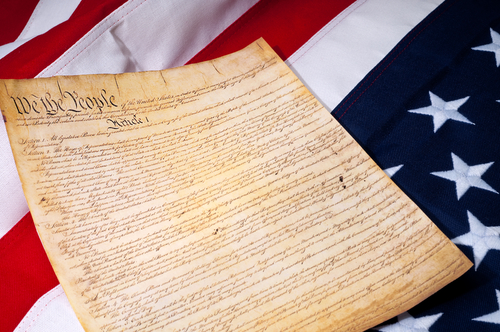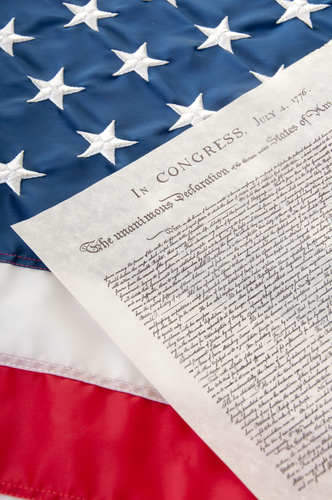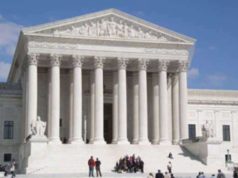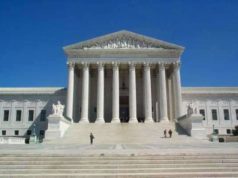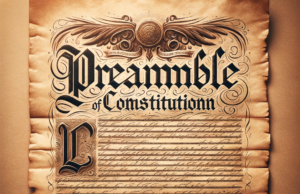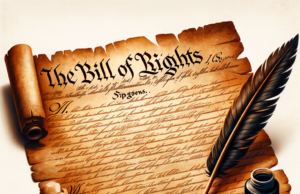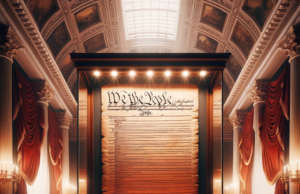Table of Contents
- 1 Amendments 1-27 in More Detail
- 1.0.1 Introduction
- 1.0.2 Amendment 1: Freedom of Speech, Religion, Press, Assembly, and Petition
- 1.0.3 Amendment 2: The Right to Bear Arms
- 1.0.4 Amendment 3: The Quartering of Soldiers
- 1.0.5 Amendment 4: The Right to Privacy
- 1.0.6 Amendment 5: Due Process of Law
- 1.0.7 Amendment 6: Right to a Fair Trial
- 1.0.8 Amendment 7: Trial by Jury
- 1.0.9 Amendment 9: Protection of Other Rights
- 1.0.10 Amendment 10: Powers of States and People
- 1.0.11 Amendment 11: Sovereign Immunity
- 1.0.12 Amendment 12: Presidential Electors
- 1.0.13 Amendment 13: Abolition of Slavery
- 1.0.14 Amendment 14: Citizenship Rights
- 1.0.15 Amendment 15: Voting Rights
- 1.0.16 Amendment 16: Federal Income Tax
- 1.0.17 Amendment 17: Direct Election of Senators
- 1.0.18 Amendment 18: Prohibition
- 1.0.19 Amendment 19: Women’s Suffrage
- 1.0.20 Amendment 20: Presidential and Congressional Terms
- 1.0.21 Amendment 21: Repeal of Prohibition
- 1.0.22 Amendment 22: Presidential Term Limits
- 1.0.23 Amendment 23: District of Columbia Voting
- 1.0.24 Amendment 24: Poll Taxes
- 1.0.25 Amendment 25: Presidential Succession and Disability
- 1.0.26 Amendment 26: Eighteen-Year-Old Voting Age
- 1.0.27 Amendment 27: Congressional Pay
- 1.0.28 Conclusion
- 1.0.29 Amendment
- 1.0.30 Amendment Process
- 1.0.31 First Ten Amendments
- 1.0.32 Reconstruction Amendments
- 1.0.33 Prohibition Amendments
- 1.0.34 Equal Rights Amendment
- 1.0.35 Platt Amendment
- 1.0.36 ADA Amendments Act of 2008
- 1.0.37 Teller Amendment

The Amendments to the United States Constitution: An Overview
Introduction
The Bill of Rights (Amendments 1-10)
Amendments 11-15
Amendments 16-20
Amendments 21-27
Conclusion
Amendments 1-27 in More Detail
Introduction
The United States Constitution sets the foundation for the country’s legal system and government. This monumental document was ratified on September 17th, 1787, and has been amended twenty-seven times since its inception. Each amendment serves as a safeguard of the rights and freedoms of United States citizens. The constitution has been a crucial foundation of the country, and without it, the U.S. would not be what it is today.
In this article, we will delve into the twenty-seven amendments, highlighting each amendment’s purpose and impact on society. The first ten amendments contain the Bill of Rights, which serves as a cornerstone of the U.S. Constitution, and the remaining seventeen amendments follow suit, protecting citizen rights and U.S. democracy as a whole.
Amendment 1: Freedom of Speech, Religion, Press, Assembly, and Petition
The First Amendment serves an essential purpose in maintaining the freedoms of United States citizens. This amendment establishes and protects citizens’ rights to freedom of speech, religion, press, assembly, and petition.
This Amendment ensures that citizens have the right to express their opinions without fear of retaliation or imprisonment. It is the foundation of freedom of religion, as it allows people to practice any religion they choose. This amendment also guarantees that press outlets have the right to publish any content they see fit. It protects the right to peaceful assembly, such as protests or gatherings, and the right to petition the government for a redress of grievances.
This amendment serves as the cornerstone of American democracy and is essential to protecting citizens’ rights to free speech and expression.
Amendment 2: The Right to Bear Arms
The Second Amendment grants citizens the right to keep and bear arms. This Amendment was created to ensure that all citizens have the right to protect themselves against personal harm or tyranny from their government.
This amendment has been a hotly contested topic in American politics, with some believing that it should be rewritten or abolished. However, those who support the second amendment insist that it is a crucial safeguard against the government and criminals who may seek to harm citizens.
Amendment 3: The Quartering of Soldiers
The Third Amendment prohibits the quartering of soldiers in civilian homes during times of peace. It was established after the colonists had to pay for the British army to live in their homes during the American Revolution.
This amendment has not been explicitly involved in modern legal cases but serves as a reminder of the founding fathers’ vision for a free society that protects its citizens’ privacy.
Amendment 4: The Right to Privacy
The Fourth Amendment grants citizens the right to privacy by prohibiting unreasonable searches and seizures of citizens’ property. It ensures that government officials cannot enter one’s home, car or other property without a warrant or probable cause.
This amendment has been the subject of much controversy in modern-day society. For example, law enforcement officials have been accused of using unreasonable search and seizure tactics on minority groups or low-income neighborhoods.
Amendment 5: Due Process of Law
The Fifth Amendment protects citizens from being held without legal justification. It also includes a grand jury requirement for criminal proceedings and prohibits double jeopardy or self-incrimination.
This amendment ensures that citizens are entitled to fair legal proceedings, and preventing the government from holding individuals without legally justified reasons or evidence.
Amendment 6: Right to a Fair Trial
The Sixth Amendment ensures that citizens have the right to a fair trial. It guarantees a speedy and public trial, an impartial jury, and the ability to question witnesses.
This amendment’s main purpose is to promote a fair criminal justice system and protect citizens from wrongful imprisonment and unjust sentencing.
Amendment 7: Trial by Jury
The Seventh Amendment guarantees citizens the right to a trial by jury in civil cases, and any case with a value exceeding $20. This amendment ensures that every citizen has a fair chance at due process of law in both civil and criminal cases.
Amendment 8: Protection against Excessive Bail and Cruel Punishment
The Eighth Amendment prohibits excessive bail and cruel punishment for criminal offenses. It ensures that individuals are not subjected to inhumane or unjust treatment during the criminal justice system.
This amendment is essential in promoting the fair treatment of individuals in the criminal justice system. However, some argue that more significant reforms are needed to prevent abuse within the criminal justice system.
Amendment 9: Protection of Other Rights
The Ninth Amendment acknowledges that the Constitution should not be interpreted exclusively. It recognizes the existence of unenumerated rights that are inherent to all citizens.
This amendment is intended to protect citizens’ rights that may not have specifically enumerated in the Constitution or Bill of Rights.
Amendment 10: Powers of States and People
The Tenth Amendment protects states’ rights and recognizes the power of citizens and states in the preservation of the federal government. This amendment ensures that the federal government’s power is not absolute and requires a balance between the central government and state governments.
This Amendment has been a subject of much controversy between the federal government and state governments over the years, highlighting the importance of a balanced political system.
Amendment 11: Sovereign Immunity
The Eleventh Amendment prohibits federal courts from hearing lawsuits brought by citizens against a state government. The amendment was established as a response to Chisholm v. Georgia, where the Supreme Court ruled that states could be held liable in federal court under the Constitution.
This amendment serves as a reminder of the balance of power between state and federal governments. However, it has also been criticized for limiting citizens’ rights to challenge state governments that may be violating civil rights.
Amendment 12: Presidential Electors
The Twelfth Amendment established a new voting system for presidents and vice presidents. The amendment required electors to cast separate ballots for the two offices and made provisions for resolving tie votes.
The Twelfth Amendment was established to prevent future elections from becoming as tumultuous as the election of 1800, which resulted in Aaron Burr’s controversial vice-presidency.
Amendment 13: Abolition of Slavery
The Thirteenth Amendment abolished slavery in the United States. The amendment ensured that all individuals have equal protection under the law and cannot be held in involuntary servitude.
This amendment was critical in eliminating an institution that was contrary to the principles of democracy and freedom that the United States was founded on. However, racial discrimination and oppression persisted even after the amendment’s implementation.
Amendment 14: Citizenship Rights
The Fourteenth Amendment granted citizenship to all individuals born or naturalized in the United States. It also established equal protections under the law and prohibited states from denying citizens their constitutional rights.
This amendment was essential in promoting equal protection and civil rights for all citizens. However, it took years of struggle and legal cases to ensure that the law was upheld in practice.
Amendment 15: Voting Rights
The Fifteenth Amendment gave citizens the right to vote regardless of their race or skin color. It aimed to prevent discriminatory barriers, such as poll taxes and literacy tests, from preventing minorities from exercising their right to vote.
This amendment was a critical step towards safeguarding citizens’ rights to democratic participation, and its principles are still prevalent in ongoing political debates.
Amendment 16: Federal Income Tax
The Sixteenth Amendment laid the foundation for the federal income tax system. It granted the federal government the power to levy and collect taxes from all forms of income, including wages and salaries.
This amendment has been a subject of much controversy and criticism, with some arguing that the income tax system is unfair to low-income families and promotes income inequality.
Amendment 17: Direct Election of Senators
The Seventeenth Amendment established the direct election of senators by the people. Before the Seventeenth Amendment, senators were elected by state legislatures, and corruption and political deals were common.
This amendment was widely celebrated as a victory for democracy and ensured that citizens had a direct say in who served in the highest levels of government.
Amendment 18: Prohibition
The Eighteenth Amendment prohibited the manufacture, sale, and transportation of alcohol in the United States. It was established in response to growing concerns over violence and corruption related to the consumption of alcohol.
This amendment was eventually repealed with the passage of the Twenty-first Amendment in 1933, marking the only repeal of a U.S. constitutional amendment.
Amendment 19: Women’s Suffrage
The Nineteenth Amendment granted women the right to vote in federal elections. It was a critical victory for the women’s suffrage movement and a step towards promoting equality and democracy in the United States.
This amendment paved the way for women’s political participation and was instrumental in promoting gender equality. However, it only granted women the right to vote and did not address other inequalities women faced in their personal and professional lives.
Amendment 20: Presidential and Congressional Terms
The Twentieth Amendment established the date and time of presidential and congressional inauguration in response to problems with the previous system, which allowed for lame-duck sessions.
This amendment was intended to promote the efficiency of government operations and prevent interruptions during election periods.
Amendment 21: Repeal of Prohibition
The Twenty-first Amendment repealed the Eighteenth Amendment, making the consumption, sale, and transportation of alcohol legal in the country again. This amendment marked the end of Prohibition in the United States.
The Twenty-first Amendment serves as a reminder that laws and policies can shift, and public opinion can play a significant role in shaping democracy over time.
Amendment 22: Presidential Term Limits
The Twenty-second Amendment established presidential term limits, ensuring that no individual could serve more than two terms as a president. It was established in response to concerns over presidents serving for excessively long periods and potentially becoming dictators.
This amendment has been a critical safeguard in promoting checks and balances within the federal government.
Amendment 23: District of Columbia Voting
The Twenty-third Amendment granted citizens of Washington, D.C., the right to vote in presidential elections. Before the amendment’s enactment, Washington, D.C., citizens lacked representation in the electoral college.
This amendment was a critical step towards promoting democratic participation and citizens’ rights to have a say in the election of their president.
Amendment 24: Poll Taxes
The Twenty-fourth Amendment abolished the use of poll taxes, which required citizens to pay a fee to vote in federal elections. The amendment aimed to prevent discriminatory practices that were used to prevent minorities and low-income citizens from casting their ballots.
This amendment was a critical step towards promoting equal voting rights, and it ensured that all citizens had a fair shot at participating in democracy.
Amendment 25: Presidential Succession and Disability
The Twenty-fifth Amendment established procedures for presidential succession and temporary presidential disability. It ensured that the government could continue to function in the event of a president’s temporary disability or death.
This amendment serves a critical function in promoting the stability of the federal government and ensuring that the country remains on track during times of crisis.
Amendment 26: Eighteen-Year-Old Voting Age
The Twenty-sixth Amendment granted 18-year-olds the right to vote in federal elections. This amendment was a critical victory for the youth suffrage movement and ensured that young citizens had the right to participate in democracy just as adults did.
This amendment has been essential in promoting democracy and ensuring that every citizen has a voice in the political system.
Amendment 27: Congressional Pay
The Twenty-seventh Amendment regulates congressional pay. It ensures that members of Congress cannot change their own pay during their term of service.
This amendment was established to prevent members of Congress from using their power and influence to enrich themselves.
Conclusion
The U.S. Constitution has been amended twenty-seven times since its inception, with the first ten amendments serving as a cornerstone of the Bill of Rights. Each amendment serves a critical purpose, promoting democracy, equality, and citizens’ rights to fair treatment under the law. These amendments have evolved over time, reflecting cultural and social changes and responding to new challenges that arise. Though sometimes controversial, the amendments serve as crucial safeguards of American democracy and promote the United States’ foundational values of freedom, equality, and democracy.
An Amendment is a change that is made to the U.S. Constitution in order to adopt a regulation or expand on the rights of individuals and groups.
Amendment
An amendment is a change that can be made to a document. Even the Constitution of the United States has the ability to be changed through Amendments. The Founding Fathers understood the necessity for a governing system that could be changed to reflect the progression and expansion of the United States.
Amendment Process
The Amendment process is a process in which a proposed Amendment is brought to the floor of Congress. The Senate and the House of Representatives are allowed to entertain this proposal and vote on it. This requires a specific majority. Once a majority vote is obtained in both Houses, the process moves to the states. There is a three-fourths requirement in order for the Amendment to be passed and implemented.
First Ten Amendments
The first ten Amendments to the Constitution of the United States are called the Bill of Rights. The Bill of Rights was created in order to outline the natural right citizens of the United States and to regulate governmental power against the American Public.
Reconstruction Amendments
Reconstruction Amendments were Amendments created after the Civil war. The purpose of these Amendments was to change the Constitution in order to reflect the views of the nation and to give former slaves the rights that they are afforded as American citizens.
Prohibition Amendments
Prohibition Amendments are Amendments made in conjunction with the Volstead Act. These regulated the manufacturing of high-proof alcohol and the distribution of alcohol in the United States.
Equal Rights Amendment
The Equal Rights Amendment has been a long-standing issue. This is an Amendment that has been brought to Congress over a number of decades. It is an Amendment that would formally state that all individuals are entitled to the same rights.
Platt Amendment
The Platt Amendment is an Amendment that was created to outline the United States’ power over Cuba after the Spanish-American War. It regulates what deals Cuba can make and what power the U.S has regarding Cuba.
ADA Amendments Act of 2008
The ADA Amendments Act of 2008 is an Act that was brought up in regards to the discrimination of disabled individuals. It requests that for cases regarding disabilities, the court system should look at whether or not discrimination is occurring and not the level of disability of the individual.
Teller Amendment
The Teller Amendment is an Amendment that was created to underline the temporary power that the United States has in regards to issues Cuba is undergoing.


